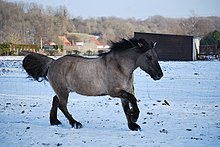
Grullo[1] (pronounced GREW-yo)[2][a] or grulla is a color of horses in the dun family, characterized by tan-gray or mouse-colored hairs on the body, often with shoulder and dorsal stripes and black barring on the lower legs. The genotype for grulla horses is a black base with dun dilution. In this coloration, each individual hair is mouse-colored, unlike a roan, which is composed of a mixture of dark and light hairs. The several shades of grulla are informally referred to with a variety of terms, including black dun, blue dun, slate grulla, silver grulla or light grulla, silver dun, or lobo dun. Silver grulla may also refer to a grulla horse with silver dapple, regardless of shade.[4]

In terms of equine coat color genetics, all of these shades are based on the dun gene acting as a dilution gene over the black gene. Because the grulla color is not due to the gray gene, a grulla horse remains the same basic color from birth, though some minor shade variation may occur from summer to winter coats. If a grulla also carries the gray gene, it will be born a mouse tan-gray shade, usually with bold primitive markings, but then lighten and eventually develop a white hair coat with age. Because black is less common in general than bay or chestnut, grulla is likewise less common than red duns or bay (classic or zebra) duns. For example, only 0.7% of quarter horses registered each year with the AQHA are grulla.
The most obvious ways to tell whether a horse is grulla are not only the gray or tan-gray body color, but also its primitive markings, which include some or all of the following: dark face, cobwebbing around the eyes and forehead, dark mottling on the body, leg barring (sometimes called tiger striping), dark ear tips and edging, dark ear barring, dark shadowing of the neck, dark dorsal and transverse striping, and light guard hairs bordering a dark mane and tail.
Cite error: There are <ref group=lower-alpha> tags or {{efn}} templates on this page, but the references will not show without a {{reflist|group=lower-alpha}} template or {{notelist}} template (see the help page).